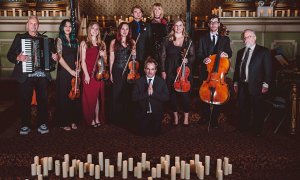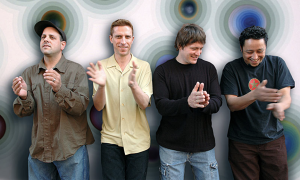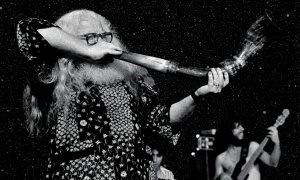Home » Jazz Articles » From the Inside Out » The Green Possibilities of Spring
The Green Possibilities of Spring
Badawi professes a percussion sound and vision unlike any other, and when he is sometimes called 'the Hendrix of percussion,' it
 Skip Heller
Skip HellerFake Book
(Hyena)
When you read that youngblood guitarist Skip Heller has played with a wide range of musicians, it means a wide range of musicians – Todd Rundgren to Yma Sumac to Big Jay McNeely to Susanna Hoffs to NRBQ and more.
On Fake Book , Heller leads John Wicks on drums, Robert Drasnin on flute, clarinet, and alto sax, guest trumpeter Jay Roulston, and organ player Doria (who sounds like he pulls double duty on keyboard bass) through a set of Heller’s favorite songs by other artists, worked out on the road and then recorded in a single afternoon in Doria’s basement. “I chose these because each one had something personal about it,” Heller reflects, “whether it was because the composer influenced me so deeply or because a song was part of a place or time I remembered.”
Right from the opener, the Grant Green / Big John Patton guitar-organ jam “The Yodel,” where clarinet mixes in the sound of real old school jazz, Heller the bandleader orchestrates an old-fashioned throwdown. Along with the soul-jazz classic “Cold Duck Time,” a showcase for ALL the soloists but especially Drasnin on alto and Roulson, it captures the spirit of this set.
Heller the guitarist shines in his Green-ish take on “Never Can Say Goodbye,” his tender and respectful solo guitar “Monk’s Mood,” and “Sophisticated Savage,” where his melodic lines flow long yet remain sharp and tangy blue, like another guitarist who shares Heller’s Philadelphia birthplace, Pat Martino.
Joel Dorn, the power behind Hyena Records who produced the original “Cold Duck Time” on the landmark Eddie Harris / Les McCann Swiss Movement set, writes in these liner notes: “This one almost coulda come out on Prestige in the 60s. But it ain’t old music, it’s brand new, and Skip’s thread in the great American tapestry.” No arguments here.
 Modereko
Modereko
Solar Igniter
(Harmonized)
One of the world’s premier “Grooverockjamjazz” bands, the Modereko quintet consists of co-founders John Molo (drums, loops, vocals) and Bobby Read (saxophones, flute, clarinet) with JT Thomas (keyboards), Dan Conway (bass), and Tim Kobza (guitar). Their collective roots are in instrumental rock of high quality (Blue Thumb, an imprint of the hallowed Verve jazz label, released their eponymous debut) and colorful variety: Thomas and Read also play with pianist Bruce Hornsby, while Molo was Hornsby’s original drummer and more recently tour drummer for Phil Lesh & Friends.
There’s just so much music here. That means more than there are a lot of songs: There’s a lot of music stuffed into each song, mixing in with casual precision goofy pop culture references, and an amazing amount of this music is quite good. Several titles reflect this joyous, almost comedic, celebration of pop culture, such as “El Kabong” and the jellyfish jam “Allman Joy,” as soft and sweet as a Georgia peach.
This follow up divides neatly (almost) into instrumentals and songs with vocals. The opener “Seven Heaven” is by far the best track with vocals, as guitar and saxophone wobble and strut against a horny backbeat that moans and groans with heavy gospel overtones. Eddie Harris could have dug into this funk with Les McCann around the time of Swiss Movement , too.
The title track stands among the best instrumentals, as Modereko continually adds and subtracts small phrases to its intricate melody like building then remodeling a Lego® house one piece at a time. In a more funky bag, “El Kabong” gets poked along by barbed horns, guitar, and organ, sounding like Booker T & The MGs sharing coffee with Herbie Mann over a Steely Dan instrumental. In “Miracles,” another old-school shuffle energized by sharp rhythm guitars and James Brown-y basslines, the ensemble playing rocks as powerful and sharp as a vintage Stax / Volt instrumental, complete with juke-joint-jumpin’ sax, guitar, and organ breakouts.
 Greyboy
Greyboy
Soul Mosaic: A Case Study in Beats, Soul and Funk
(Ubiquity)
The first set in three years from Southern California’s premier producer / DJ Andreas Stevens marks a decade since his Freestylin’ debut helped establish acid jazz as a modern musical force.
Soul Mosaic settles Greyboy nicely into the niche he helped create. Its instrumental tracks whack back to the retro-70’s soundtrack feel of his previous Mastered the Art set, and the tracks with vocals are truly songs and not just instrumental tracks with vocals. Bart Davenport sings on two possible singles, an update of Stevie Wonder’s “To Know You is to Love You” and “Genevieve,” nominated for “Track of the Year” by the BBC Radio1 “Worldwide” show.
UK producer Quantic (Will Holland) delivers a smokin’ bonus remix of “Genevieve,” nudging it from Greyboy toward the more European hip-hopster Guru, and guests with (US) East Coast vocalist Sharon Jones on “Got To Be A Love”; Jones also scorches “Got To Stand For Something,” while Paul Nice remodels “Got To Be A Love” as another bonus remix. Miss Jones’ vocals bubble with just the right blend of sweet, sassy, soulful and sexy – the hip-hop Chaka Khan.
A skeletal yet throbbing rhythm track supports Davenport’s strong “Genevieve” vocal, and its falsetto bridge dusted with acoustic guitar creates a Curtis Mayfield old-school soul sound that Bing Ji Ling echoes in “So Good” later in the set – an unique blend of futuristic (techno) funk and retro soul. The harmonica solo, once a “Little Stevie” trademark, helps Davenport nail down the composer’s sound in the Wonder cover, as does the instrumental track that glides like a speed skater across sleek ice.
Greyboy still delivers state-of-the-art instrumental jams, serving beats chopped and looped with D-Styles and Ricci Rucker in “Son Ray,” “Omega” (cut from the same 1970s sci-fi soundtrack cloth as “Logan’s Run” from Mastered the Art ), and the most beat funkiest “Big Tito.”
 Badawi
Badawi
Clones & False Prophets
(ROIR)
No one brings the past and the future together into the present quite like Raz Mesinai (Badawi). Born in Jerusalem, Mesinai split his childhood between there and New York City, spending much of his time in Jerusalem studying Middle Eastern percussion in the Sinai desert with Bedouins and his time in NYC expanding into Afro-Cuban, Moroccan, Persian, Indian, and other styles. He professes a percussion sound and vision unlike any other, and when he is sometimes called “the Hendrix of percussion,” it’s not much of an exaggeration.
Badawi arms himself against these Clones with percussion, flute, piano, electronics, and some of NYC’s most veteran progressive musicians in guitarist Marc Ribot and clarinetist Doug Wieselman, plus drummer Ben Perowski, bassist Shahzad Ismaily, and vocalist Carolyn “Honeychild” Coleman.
“Enter the Etherics” – exotically timed, with clarinet evoking the middle eastern sound of the shanai and flute dancing in colorful robes against the cataclysmic percussion background – raises the curtain on what suggests a soundtrack for a yet-to-be-filmed Old Testament epic comprised not so much of songs but of musical pieces , of sound sculptures .
The first four tracks set the stage for “The Circle,” which draws battlelines for the ensuing, climactic “Battle Cry.” Though every other song slowly writhes to life like a newborn serpent, “Battle Cry” explodes like simultaneous strikes of lightning and thunder. Powerful and violent, it unleashes the furious instrumental sound of King Crimson wandering lost for forty days in the Sinai, Ribot spitting guitar venom, ending in the final dying gasps of a radio transmission from the battlefield front.
Thanks to their drum and bass, “Enter the False Prophets” which bleeds into “False Dub” expand the Badawi sound and rhythm palette into the reggae / dub backbeat of the Caribbean, albeit twisted and very darkly toasted.
 James Hollihan
James Hollihan
The Funky Misfit
(Nuevotron)
“I’ve always had a passion for jazz,” allows multi-instrumentalist and producer Hollihan. “I’ve always loved the music of composers like Henry Mancini, Michel Legrand, Johnny Mandel, and the one and only Juan Garcia Esquivel. It was only a matter of time before all those influences came bubbling up.”
Hollihan is no stranger to a recording studio, having performed with Russ Taff, Phil Keaggy and Amy Grant and produced sessions by Taff, Michelle Shocked and Marshall Chapman. Hollihan owns a Grammy for Taff’s album Under Their Influence album, which he recorded in his own basement. He composed, arranged, performed, recorded, mixed and produced every bubbly Funky Misfit note himself.
On the first two tracks, “The Funky Misfit” and “Groove DeVille,” Hollihan’s sounds and rhythms pop with colorful, charming futuristic-retro lounge kitsch. His guitar work SO sounds like Grant Green’s in the title, opening cut, a melodic serpentine that creeps through surprising twists and starts, and his tight mid-song solo opens with what sounds like bubbling guitar laughter. “Groove DeVille” is precisely that, a luxury sedan groove with more (Grant) Green reflections from Hollihan’s guitar.
The rest of this is smooth and soft, though several similar-sounding tracks near the middle sort of run into each other. Hollihan has a velvet touch not only as a guitarist but as a pianist, as in “Solitude” and “The Waltz of the Leaves.” He returns to shades of guitarist Green in “The Hush of Love,” which sets such a romantic mood that it almost aches for Luther Vandross vocals.
The sound and feel of Brazil seem to dominate the remainder. “It Came From Brazil” not only sambas in the hypnotic rhythms of Jobim but also the keyboard sounds of Eumir Deodato, sparkling cool water splashed on the rocks in an interstellar spacejazz lounge. “Across the Desert Sky” and the soft waves of rhythm that lap upon “Cypress Shores” also whisper with the romantic, languid sounds and rhythms of Brazil, as Hollihan’s acoustic guitar sparkles through their tropical mix like brilliant starlight.
< Previous
Omnitone Records
Next >
Give
Comments
Tags
For the Love of Jazz
 All About Jazz has been a pillar of jazz since 1995, championing it as an art form and, more importantly, supporting the musicians who create it. Our enduring commitment has made "AAJ" one of the most culturally important websites of its kind, read by hundreds of thousands of fans, musicians and industry figures every month.
All About Jazz has been a pillar of jazz since 1995, championing it as an art form and, more importantly, supporting the musicians who create it. Our enduring commitment has made "AAJ" one of the most culturally important websites of its kind, read by hundreds of thousands of fans, musicians and industry figures every month.






















